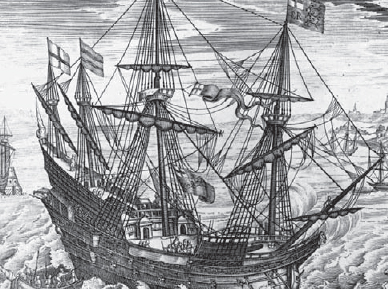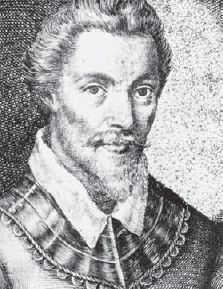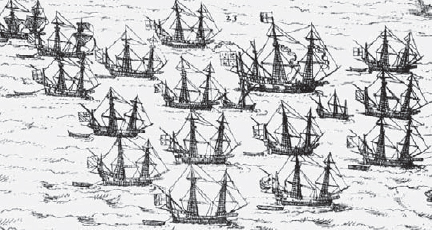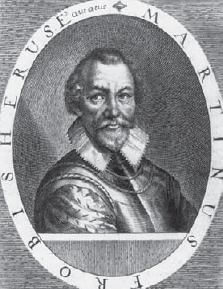
Relations between England and Spain had been deteriorating steadily for a quarter of a century, ever since the accession of Queen Elizabeth in late 1558. By 1584 they had reached an all-time low. Religion lay at the heart of the problem. Elizabeth was a Protestant, as were the majority of her subjects, while King Philip II of Spain was a devout Catholic, and a staunch supporter of the Counter-Reformation. The imprisonment of the Catholic Mary, Queen of Scots in 1568 and the Hawkins expedition which ended in the same year did little to improve diplomatic relations, nor did Elizabeth’s covert support for the Dutch Protestants, who revolted against Spanish rule during the early 1570s. These events were followed by Drake’s two expeditions of 1572–74 and 1577–80. Elizabeth’s open admiration for a man the Spanish viewed as a pirate only served to heighten the tension.
Drake’s raid into the Pacific coincided with a major Spanish offensive in the Netherlands. From 1578 to 1580 the Duke of Parma’s Spanish veterans succeeded in driving the rebels from what is now Belgium, until only Antwerp remained in Protestant hands. It was then only a matter of time before Parma captured the city. Then in 1580 the Spanish invaded Portugal, and captured their neighbouring country after a lightning campaign. The spoils included a powerful squadron of Portuguese galleons, and two years later these warships were at the forefront of a naval campaign that saw the Spanish fleet emerge victorious over the remnants of the Portuguese and their French allies. Spain now had naval muscle, and seemed willing to use it.
The Spanish were also intervening closer to home. In late 1580 a small Spanish expedition was sent to Ireland, to encourage a general Catholic rising there. The English fleet blockaded the Spanish at Smerwick on Ireland’s west coast, and the expeditionary force was eventually compelled to surrender. In 1584 the English began planning an expedition designed to establish a colony in the Americas, a land the Spanish regarded as their own. Also in 1584 the Spanish negotiated a treaty with the French Catholics, providing men, money and arms to help drive the Huguenots from French soil. Each of these incidents served to increase the political tension, and showed that Philip II was embarked on a crusade on behalf of the Catholic Church.

Here is another depiction of an Elizabethan warship, this time showing the White Bear (732 tons), one of the most powerful vessels in the royal fleet. Both this engraving and the complementary one of the Golden Lion on p.14 were drawn by Claes Jansz Visscher.
While war wasn’t inevitable in 1584, it was probably the last chance for peace. Elizabeth and her advisors honestly believed that by launching an expedition against the Spanish they would be able to deter Philip from going on the offensive against them. That would buy time for the diplomats to avert a conflict. Since his return to England in 1580 Drake had been arguing that a strike of this kind was needed, especially if the English could find a way of exploiting Portuguese and Spanish rivalry. Drake originally proposed an expedition to the East Indies, and as late as November 1584 the merits of this plan were being debated by Elizabeth’s counsellors, including the Earl of Leicester and John Hawkins. In the end, political developments led to a change of plan.
In early 1585, Queen Elizabeth ordered negotiations to be opened with the Dutch, whereby England would recognize their independence and become their ally and protector. In May, Philip responded by ordering the seizure of all English shipping in Spanish ports. Both sides were increasing the stakes in a game of brinkmanship. Elizabeth’s response was to use Drake to raise the stakes even further. He would be invited to visit the ports of Spain, and demand the return of the ships, or recompense. If it wasn’t forthcoming, then pre-arranged letters of reprisal would come into effect, and he would therefore be able to attack the Spanish and plunder their own ships and towns, by way of reprisal. This then was the political foundation of the expedition. However, like any Elizabethan venture of this kind, it would be organized as a financial as well as a military or naval venture.
Drake’s expedition was organized as a joint-stock enterprise. That meant that various individuals put up a stake in the venture, in money, ships, men or resources. They all expected a return in the form of a share of the plunder. No plunder meant no profit for the investors. The names of the principal shareholders remain a secret, but almost certainly they included Queen Elizabeth, the Earls of Bedford, Leicester, Rutland and Shrewsbury, John and William Hawkins, Walter Raleigh, Sir Christopher Hatton and Sir Francis Drake himself.
Most of these men contributed ships to the expedition. The Earl of Leicester provided the tiny Speedwell and the purpose-built 400-ton privateer Galleon Leicester, commanded by his brother-in-law Francis Knollys. Sir William Wynter provided the Sea Dragon, Lord Howard of Effingham supplied the White Lion (commanded by Captain Erisey), while the Hawkins brothers offered the Bark Bond (Robert Crosse), the Bark Bonner (George Fortescue), the Bark Hawkins (William Hawkins), the Hope and the Galliot Duck (Richard Hawkins). Drake’s own ships included the Thomas Drake (commanded by its namesake), the Elizabeth Drake (John Vamey) and the Francis (Thomas Moone), but he flew his flag in a royal warship, the Elizabeth Bonaventure.

During his great raid on the Spanish Main (1585–86) Sir Francis Drake used the royal warship Elizabeth Bonaventure as his flagship. She was a fairly elderly vessel, having been bought by the Royal Exchequer from an English shipowner in 1567. The vessel herself was of course even older than that, and it has been suggested she was first built during the reign of Queen Mary (1553–58). At the time she was described as a ‘galleon’, of around 600 tons.
In 1581 she was extensively rebuilt by Sir John Hawkins, and she emerged from the royal shipyard in Deptford as a new vessel – a ‘race-built galleon’, a faster and more manoeuvrable English version of the Spanish galleon. Part of this rebuilding involved reducing her superstructure, and turning her into a sleek four-masted warship of 448 tons.
The Elizabeth Bonaventure was less than 100ft long at the waterline, and just 120ft overall, with a beam of 52ft. These dimensions made her a good gun platform, and she mounted an imposing armament for a ship of her size – 39 guns, including two demi-cannon, 11 culverins and 14 demi-culverins. She performed well during the expedition, and so Drake retained her as his flagship during his raid on Cadiz in 1587, and his pursuit of the Spanish treasure fleets later that same year. She outlived both Francis Drake and Queen Elizabeth, and was finally sent to the breaker’s yard in 1611.

Drake’s land commander, Lieutenant-General Christopher Carleill was an experienced soldier, having fought in the Spanish Netherlands before joining forces with Drake. He proved to be an inspiring leader, and led his soldiers to victory at Santo Domingo and Cartagena.
The Queen’s stake was £10,000 in money and two ships – the 600-ton Elizabeth Bonaventure and the 250-ton Aid. Their joint value was placed at £10,000, a deliberate over-valuing to enable the monarch to draw a larger profit from the expedition than she would otherwise be entitled to. In fact, she wasn’t the stakeholder here – it was the English taxpayer, operating in her name. Her only tangible benefit from a successful expedition would have been the political discomfiture of her rival monarch. Both ships had been rebuilt, and Drake’s flagship was regarded as being a particularly impressive vessel. Other ships were supplied by London merchants, or their counterparts from West Country ports.
This expedition was therefore not purely a great piratical or privateering raid – it was a commercial enterprise, with carefully laid down goals. By diverting New World revenue from Spanish to English coffers, Elizabeth and her fellow backers were depriving the Spanish of the resources they needed to wage war, while increasing their own ability to defend themselves and their Dutch allies. In Elizabethan England business, politics and privateering were all hopelessly intertwined. As admiral, Drake commanded a force of 29 ships of various sizes, from the Elizabeth Bonaventure down to small 20-ton pinnaces. His deputy – or vice-admiral – was Martin Frobisher, a highly experienced but harsh seaman from Yorkshire who had already made his name as both a privateer and an Arctic explorer. He flew his flag in the 400-ton Primrose, supplied by London merchants. The Lieutenant-General of the expedition, Christopher Carleill, who commanded all land forces, hoisted his standard in another London ship, the 150-ton Tiger. Carleill was a stepson of Sir Francis Walsingham, and an experienced soldier and would-be explorer. Together these men commanded the largest fleet England had ever sent into American waters.

In this detail of the engraving by Theodore de Bry, the English fleet is depicted lying at anchor off Santo Domingo. The Elizabeth Bonaventure was the largest vessel in the fleet, and is identifiable as Drake’s flagship, as it is shown flying the royal standard.

Although he was a renowned explorer, privateer and Elizabethan ‘Sea Dog’ in his own right, Martin Frobisher (c. 1539–94), Drake’s naval second-incommand, was content to let his admiral make the decisions, and merely provided him with experienced counsel.
Carleill’s force consisted of 12 companies of soldiers – around 1,600 men – and while these troops were largely inexperienced, Carleill himself knew his business, as did his sergeant-major (the equivalent of a major-general) Anthony Powell, and his two ‘Corporals in the Field’ (the equivalent of colonels), Matthew Morgan and John Simpson. Together these officers would make sure that the soldiers did what was expected of them. If we add the seamen to the total, Drake commanded almost 2,300 men and boys. He managed to avoid being encumbered with too many courtiers and adventurers. These included Sir Fulke Greville, Sir Philip Sidney and the adventurer Don Antonio, all of whom were left behind when Drake sailed. This meant that for the most part Drake’s officers and men were seasoned professionals, and it was unlikely that he would encounter the same dissent that had hindered him during his voyage to the Pacific.
Drake already had his official instructions, and he had been fully briefed on the need to go through the motions of demanding redress from the Spanish. He also realized that this was little more than a diplomatic nicety. His real objective was the Spanish Main, where it was expected that he would raid the Spanish colonies, disrupt their trade and ideally intercept the annual treasure flota. For once he had the ships and men he needed to tackle this powerful Spanish force head-on. Sir Francis Walsingham – Elizabeth’s foreign policy advisor and ‘spymaster’ – told Drake that he hoped the hardest possible blow would be struck by him.
This voyage was therefore seen by Walsingham as a pre-emptive rather than a diplomatic measure, aimed at depriving the Spanish King of the wherewithal to wage a naval war against England. It was up to Drake how he would carry this out. After all, he knew the Caribbean like few other Englishmen, and he had spent years studying Spanish strengths and weaknesses in the New World. Drake was one of the few men who could fulfil these political objectives while satisfying the expedition’s shareholders at the same time. This said, as September drew to a close Drake was eager to sail. His dread would be a last-minute recall, as the Queen had second thoughts about launching this risky strike against the Spanish New World. In the end, Drake would sooner sail before all his preparations were ready than miss the chance to continue his own private war against the Spanish, this time with the resources he needed to inflict a telling blow against his enemies.